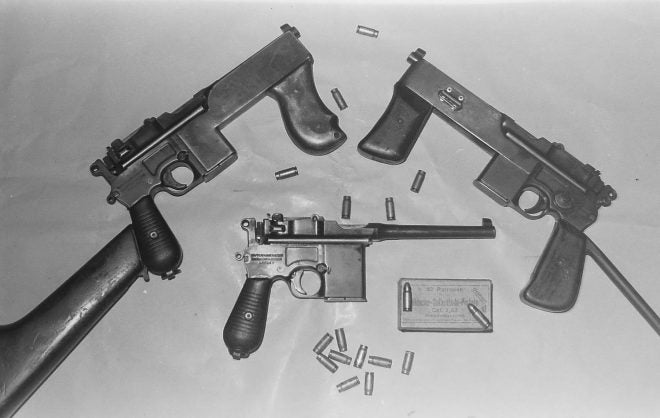A pretty well known icon in the firearms world is the 7.63x25mm German Mauser C96 (Construktion 1896) pistol which began to appear worldwide in the late 19th Century, and reached extreme popularity in the 1920s and 1930s, the last production examples coming out of the Waffenfabrik Mauser, in Oberndorf a. Neckar, in 1938. The popular semi-auto “Broomhandle” (from the shape of its wooden grip), with its characteristic wooden holster that could be attached to the gun to act as a shoulder stock, soon had selective-fire Spanish-made copies (Royal and Astra) flooding the international market. Although the actual usefulness of such light guns in the automatic mode was already open to question, they did represent a solid market attraction those days, even it was for status symbol, only. And this was not ignored by the German firm.
Joseph Nickl, an Austrian-born employee at the Oberndorf factory, was given the responsibility to redesign the pistol’s action accordingly, and required patents were issued in Germany in 1930 and in the United States four years later. The resulting weapon, which was called the Schnellfeur Pistole (Rapid-fire Pistol), externally resembled, to all extents and purposes, the C96 Military Model, but featured a fire selector lever on the left side of the frame, between the pistol grip and the trigger guard, with settings for semi-automatic, forward, and full-auto, to the rear. The original feeding system, a 10-round clip that was inserted from the top in the open action, was replaced with a more conventional detachable box magazine, of 10-round capacity in most cases, but also existing for 20 or even 40 rounds. Like all other Mauser “Broomhandle” pistols of that time, the selective-fire variants were sold with the typical wooden holster/stock which somewhat converted them into mini-carbines.
Reported malfunctions found on some Nickl-designed models, of which only 4,000 or so examples were manufactured, led Mauser to further redesign the weapon, the improved mechanism being the brainchild of Karl Westinger. This was a remarkable success, and the production run between 1931 and 1938 totaled some 98,000 guns generally designated as the M1932 (for export) or M712 (German Army). The most obvious external difference was the fire selector, now a semi-circular job with a pointed tip, locked in position by a spring-loaded button in the center.

One of the Schnellfeur pistols in the original configuration is “Policia Militar D.F. No.271”, Serial 81297.
The 7.63x25mm Mauser-in-rock-and-roll somehow achieved a substantial commercial success, with a dozen or so countries ordering it for their military and police forces during the Thirties, Brazil being one of them. Although it was never officially adopted by the local Army, a number of Police forces did order it, one of them being the PMDF (Polícia Militar do Distrito Federal, Federal District Military Police), which purchased about 500 in the mid-1930s. They were all of the M1932 Schnellfeur model with detachable magazines, of which only the 10-round units appear to have been delivered, becoming generally known as the PASAMs (Pistolas Automáticas e Semi-Automáticas Mauser, Mauser Automatic and Semi-Automatic Pistols). Believe it or not, they remained in operational use with what had become the PMERJ (Polícia Militar do Estado do Rio de Janeiro, Rio de Janeiro State Military Police) well into the early-1980s.
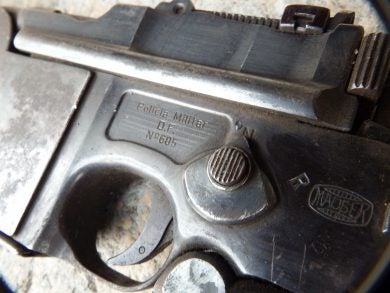
The characteristic fire selection switch of the Schnellfeur in Brazilian service had the markings “N” (for Normal, semi-auto mode) and “R” (Rajada, or Burst).
But the Brazilians – like probably everybody else – were soon to learn that the full-auto capability of the Mausers didn’t have much usefulness/effectiveness in the real world. With a cyclic rate-of-fire of 850-900 rounds per minute, magazines were emptied in slightly over one second (!), and controllability was all but non-existent, even with the use of the wooden stock unit. In 1970, then, a sedative first step was given by PMERJ by asking a local Rio de Janeiro gunsmith, Spanish-born Jener Daumau Arroyo, to modify a number of the weapons to improve their handling characteristics.
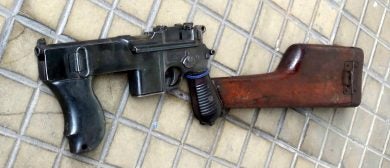
“Mod. 01” PASAM (Polícia Militar D.F. No. 470, Serial 80676) with metal foregrip under the frame extension, which received a transversal sling attachment.
The first model, of which 101 were modified, received a metal frame extension welded to the magazine housing, and was fitted with a forward metal grip well ahead of the gun, under the muzzle, while retaining the original conical wooden grip, which allowed the attachment of the holster/stock. A second modification, involving 89 pistols, featured a similar frame extension, but the forward grip being either like the “Modification 1” model or of a different, flat shape with wooden panels. The rear grip was entirely redesigned to a longer and flatter profile, a 320mm-long fixed tubular stock being attached to the rear of the frame. In both models, of course, the 132mm barrel was left free so as to enable it to do its short recoil during fire. For the record, 295 PASAMs were left in the original condition. The Brazilian guns were all in the 80,000 serial number range, meaning later production examples (the Schnellfeur had its own sequence of manufacturing numbers).

The “Mod. 2” batch involved 89 pistols. This particular example (“Policia Militar D.F. No. 605”, Serial 81398) sports the same fore grip of “Mod.1” gun plus an all-metal, re-shaped main grip.
Back in 1983, when the German guns were still in service with Rio’s Military Police, I had the opportunity to take the three models to a firing range in a suburban area, courtesy of then-Major Paulo Cesar Amêndola, P3 (Operations Officer) of the 4 BPM (Batalhão de Polícia Militar, Military Police Battalion) to test fire them. I can’t avoid telling you that this brilliant officer was, at the time, pretty busy establishing within the PMERJ the COE (Companhia de Operações Especiais, Special Operations Company), a small unit that would later (1991) become the now-famous BOPE (Batalhão de Operações Policiais Especiais, Special Police Operations Battalion). What follows is a general recall of what happened in Rio de Janeiro that rainy September morning.
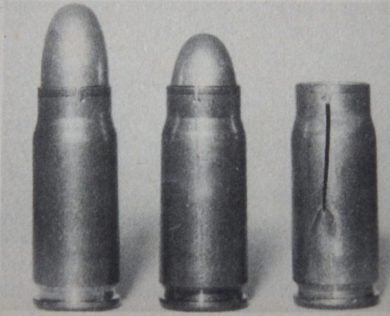
Ammo used in the 1983 test (left to right): unused round has tiny crack; stove-piped round has bullet pushed into case and enlarged crack; fired case clearly shows rupture and powder burn marks.
To go with the granddad pistols, I was supplied with some granddad…ammo, German-made (Rheinish-Westfälische Sprenstoff A.G.) “Patronen” of unidentified manufacture date. From the very disgusting appearance of both the boxes (some had termite-made holes in them!) and the rounds themselves, I could have bet that they were contemporary to the guns, that is, just about a half-century old. Had I taken a closer look at the rounds, I would have noticed that they all had tiny cracks running from the top of the case down to the bottleneck. Upon firing, these cracks consistently resulted in cases rupturing about 1mm halfway down their lengths. Duds? About two or three out of every 50 shots fired.
I started with a plain Schnellfeur (serial number 80,170) with the wooden stock attached, and soon could just confirm what other people had often described, that is, that the full-auto option was an exercise of futility at ranges over 5 or so meters. And one wonders why Mauser fitted the gun with a tangent rear sight optimistically graduated all the way to 1,000 meters (!), even for a pistol with comparatively long barrel. Anyway, my improvised range only allowed firing to about 20-30 meters, so sight graduations were, in the event, a mere curiosity.
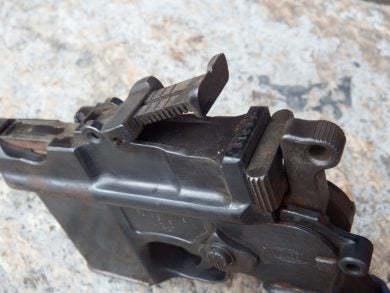
The rear sight of the standard Schnellfeur pistol raised to the maximum (1,000 meters) setting, a pretty hopeful expectation for a 7.63x25mm shot from a 132mm barrel.
Another detail is that the wooden stock fit somewhat high in the grip, not leaving too much space for the firing hand. The particularly long travel of the hammer (which itself is pretty large) might eventually “bite” the top of the hand if no care was taken. So, myself being small-handed – and having previously been warned of the hazard – was a definite bonus in this case.
Some stove-pipe incidents occurred during the feeding process, and each and every time resulted in the bullet being pushed as much as 4mm into the case, enlarging those tiny cracks in the brass. As ammo supply was not particularly abundant, most of the rounds were, in fact, re-used and fired with no apparent problems. Throughout that unforgettable firing session, incidentally, no extraction/ejection problems occurred with any of the three guns involved, but feeding incidents did show up. When the last round was fired, the bolt remained open, a common feature in most semi-auto pistols today, but which was pioneered by Mauserwerk, I think.
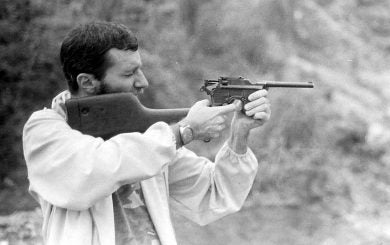
Firing the unmodified PASAM from the shoulder. Note the cocking piece in its rearmost travel position pushing the hammer back. Ear and eye protection? Well, those were wild days…
Then I turned to what I call “Modification One” (serial number 80,646), the one which retained the original pistol grip and holster/stock attachment, but was fitted with an all-metal forward grip. From the start, full-auto was selected (selector to the “R” position, rear), and I hopefully elected not to fit the shoulder stock and fire from the hip holding the two grips: just a couple of hits from the 10-round magazine punched holes in the man-sized target bravely facing me… at only about 5 meters! Although the generated recoil of the 7.63×25 ammo was, no doubt, modest, the high rate of fire made the muzzle rise quickly, and when I tried countering the momentum… the party was over.
In the semi-automatic mode, however, the modification proved okay: stock attached, the wider grip base plus the increased general weight, made the weapon a nasty little carbine pretty effective at the ranges at hand. On the negative side, there was still that somewhat awkward wooden stock, which complicated a little the grip of the firing and (remember that hammer “bite”?).

The 10-round box magazine being inserted into the “Mod.2” PASAM, the action remaining open after the previous last shot. The 20-round unit, not supplied to Brazil, would have been more practical. Note distinct shape of the vertical fore grip with wooden side panels fitted to this example.
This is probably what led to “Modification Two”, in which the rear grip (either all-metal or with wooden panels) was enlarged and flattened, and with two variants of forward grips. The fixed metal stock attached above where my firing hand was, thus providing a natural and solid protection against the hammer. And the so-modified PASAM took on a compact submachine gun look, but as I was soon to find out during my shooting, the small-capacity magazines made me forget about it. Maybe the 20-round magazine, which was not supplied to Brazil, would help a little, more so a 40-round one that was manufactured once.

Preparing to fire the “Modification 2” from the shoulder, hammer cocked. Now, 33 years later, I can’t remember why my left thumb was not fully holding the vertical support grip…
Firing from the shoulder, the skinny stock was just comfortable enough for the job, while in Hollywood-style, hip-firing it helped in holding the gun steady, pressed against my side. In that configuration, the gun had an overall length of about 600mm, compact enough to be carried around and used in patrol cars, for example.
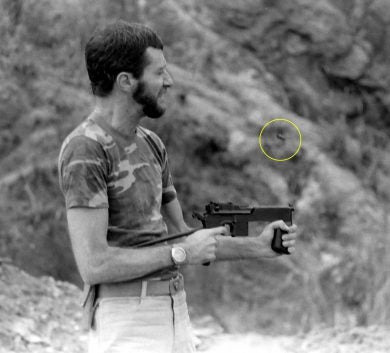
Firing the “Mod.2” in the full-auto mode, Hollywood-style. My East German Exakta camera, used by 13-old son Alexander to show dad in action, was still able to catch an empty cartridge flying up.
The PASAMs remained in service for just a little longer (mid-1980s, at most), and somehow faded away in obscurity. There were plans to offer them for sale in the U.S. collectors’ market, but, unfortunately, nothing ever came out of that. It just so happened that I was recently talking about those guns, and began to wonder about their current fate. Contacts with PMERJ friends eventually resulted positive: yes, they were still around in some local warehouse! And I was soon allowed to meet them again after 33 years, and take the brand-new color pictures that you see here. Enjoy!
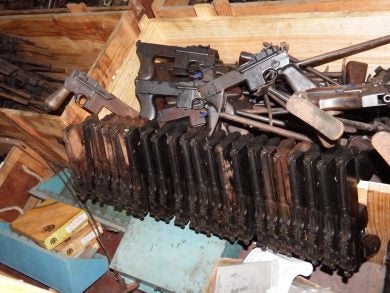
Regrettably, a whole bunch of PASAMs are now rusting in a Rio de Janeiro Military Police warehouse. Twenty-three “Mod.1” guns can be seen lined up in the foreground, with a pile of “Mod.2” variants behind.
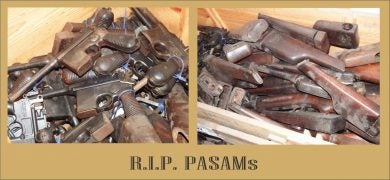
Original Mauser Schnellfeur pistols, together with their wooden holster/stock attachments, await a more respectful destiny in Rio de Janeiro.
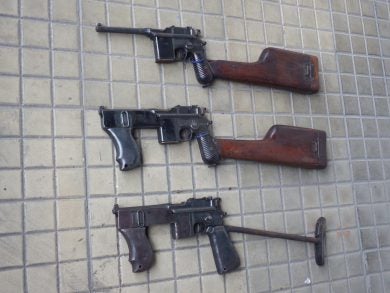
Seen together, the three PASAM models used by PMERJ clearly show the configuration changes.
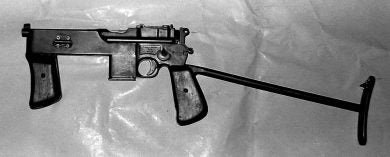
A better look at the “Modification 2” PASAM fired by the author in 1983 will show a forward grip of different shape, with wooden panels, and the front sling attachment in a longitudinal (rather than transversal) location on the left side of the frame extension.

This close-up view of a “Mod.2” pistol shows how the frame extension leaves the barrel free to travel rearwards (short recoil) during fire.

With no stock fitted and the 10-round magazine outside its housing, this “Mod.2” displays the sturdy metal forward grip.
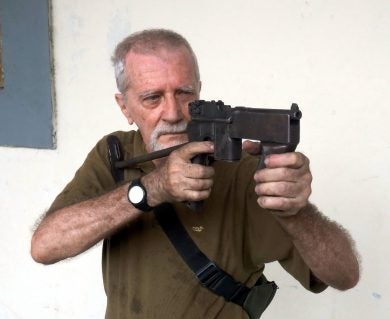
Author just posing with a “Mod.2” PASAM in the firing position, remembering the old times. Still, no ear or eye protection…Lol
 Your Privacy Choices
Your Privacy Choices
